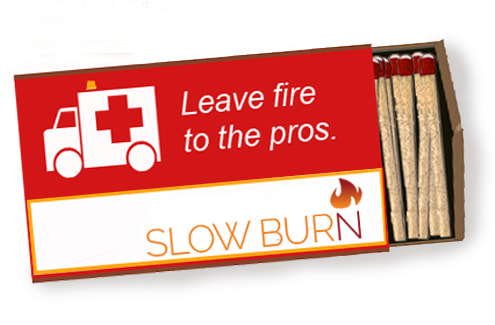 ...or listen to it hear, in the author's own voice. ...or listen to it hear, in the author's own voice. Recently, I'd been sent a solicitation by a major internet radio provider. They're one of the few online radio platforms that has a distinctive and unique position. There is no other service like it, and it's one of the reasons I listen to it. When it comes to music, my terrestrial radio market is marginal at best. One of the only reasons I listen to commercial radio is to find really awful radio advertising. But we're off topic. This major internet radio provider sent me a solicitation disguised as a primer. The lesson? How to tell powerful brand stories using audio. I ADMIT IT: MY CURIOSITY WAS PIQUED As a longtime writer of radio advertising, and as an award-winning, audio-loving, ROI-producing, brand-story-telling small-business marketeer, I'm always looking for insight into telling brand stories. In fact, I just saw a terrific little video starring Bo Eason, the former NFL player turned story guru. He talked about four crucial tips for successful storytelling. He was great. So, in this mode, I clicked on the link to this ostensible lesson from the internet provider on how to tell brand stories using audio. Interestingly, they also four crucial tips. But as I wound my way through the copy to get to the tips, I was concerned. This was not shaping up to be enormously insightful. AND BY THE FIRST OF THEIR FOUR ESSENTIALS, IT WAS EVIDENT WE WERE IN TROUBLE Ready? 1. USE A CONVERSATIONAL TONE Most audio is consumed through earbuds, so there is no need to shout anymore. Consumers will appreciate you more for speaking to them like you would a friend. Um... Let's forget the assertion that it's all about earbuds now. There's no need to shout anymore? Friend, I hate to tell you this, but there never was any need to shout. Shouting out of the radio has always been the province of those with nothing to say. Have I ever shouted out of the radio? Of course. And it was always in an effort to make fun of the people who feel they need to shout out of the radio. SPEAKING AS IF TO A FRIEND HAS LONG BEEN AN ESSENTIAL TRUTH Since the beginning, radio advertising has worked best when delivered as a conversation. Speaking one-on-one to your listener has sold untold billions worth of product. Even epic and successful efforts that one might remember as "shouting," when you go back and revisit them, are not shouting at all. Look at a hugely successful radio ad campaign that ran for years, and created a significant sales increase for Bud Light: The "Real Men Of Genius" campaign. Double-digit percentage gains in market share, over 100 advertising awards, CD compilations of the commercials, endless parodies (which is ironic, as the campaign itself was a satire), the Bud Light "Real Men Of Genius" campaign was gold. And announcer Pete Stacker shouted his way through that campaign, right? REMEMBER THAT? If you do...you'd be wrong. But a lot of folks who like to imitate Pete Stacker's brilliantly deadpan, self-important baritone on those messages get it completely wrong. One of the reasons it works is because it is larger than life while still being on the down low and part of a conversation that gives you enough credit to be in on the joke. "But what about all those car dealer commercials that shout at you out of the radio," you ask. "Doesn't that prove that shouting is a viable and necessary approach to radio advertising?" It does nothing of the kind. It proves only that those messages exist. It tells you nothing about their efficacy. "But," you ask, "Why would they keep doing it if it didn't work?" WELL, A COUPLE OF REASONS WHY SHOUTING MIGHT WORK If you shout and you spend more money than anyone else, you're bound to get some traffic. You're essentially annoying people into remembering you. But I once worked with a Los Angeles car dealer on their radio, using the exact opposite approach. Intimate, one-on-one conversation. Honest and real and friendly and engaging. They had tiny radio budget. And every month, their new-car inventory sold out. There is no need to shout. There never has been. And to tell your prospect, someone who's considering using internet radio advertising, that there is no need to shout "anymore" immediately brings your credibility as an audio advertising authority into question. AND IT MAKES PEOPLE LIKE ME CRAZY At best, you're stating a truth that never was. At worst, and I fear this is the case, you have no clue. OK, so earth-shaking creative truth number one is predicated on a fallacy. What about the other three truths? Well, the second truth was about speaking to an individual and making it personal. Truth indeed! Can't argue. It's not new. But it's essential. Truth number three, have a clear call-to-action. Again, truth! Can't argue. BUT THE FOURTH TRUTH IS MUDDLED It's about complementing the audio advertising with display. The internet radio provider asserts that, "In an ideal scenario, audio and display go hand-in-hand. Let the audio message deliver the hardworking information, while the display captures the eyes." Here's my big, fear, which is probably not the reality: "Have a really good display ad up when your audio message is playing! That's the ticket." Because everybody who listens to the radio sits there staring at it the entire time, regardless of whether it's an old fashioned terrestrial radio signal pumped out of an antenna farm, or a flurry of zeroes and ones pumped out of your internet provider's server farm. I suspect, I hope, this is wrong. I hope that what they really mean is having a complementary media mix. Which is good. Here's the problem: How on earth does an audio message "deliver the hardworking information"? AUDIO MESSAGES WORK BEST NOT WITH FACTS AND DETAILS... They work best by creating a feeling and focusing on a simple, easy to comprehend message. So, what is the "hardworking information" that this audio advertisement is supposed to deliver? If it's a focused, emotionally evocative message, right on! If this is supposed to mean that you want to deliver all the hard facts in your audio message, well... You need to study radio advertising 101. So, why are we harping on all this? BECAUSE I AM ANNOYED Yes. It's all about me. That's because I have spent a huge portion of my professional life dealing with the psychology and the techniques behind sales messages. And lately, I've been venturing into the digital realm to augment my toolbox. The ongoing problem is that I'm besieged by excited, enthusiastic young professionals who have all kinds of new information to convey-and they are completely reinventing the wheel without ever having understood the genius of the wheel in the first place. The technology has evolved. Human beings have not. YES, PEOPLE MIGHT BE PAYING LESS ATTENTION THAN BEFORE That just means we need to be even more skilled at the essentials. And that skill requires understanding what makes people listen (or read, or watch), and then feel compelled to act. It means looking at and understanding the historical truths about advertising. Oooh, "advertising" is a dirty word now. So is "radio." Get over it, kids. "Radio" is from the Latin "radius," for "beam" or "ray." AND JUST BECAUSE YOU'RE BEAMING DIGITS FROM A SERVER DOESN'T CHANGE PEOPLE It doesn't change their psychological triggers. It doesn't change their need for story. It doesn't change the decades-old, proven, historical truths about advertising. And it doesn't change the elemental foundation of branding a business before ever going out to advertise it. The self-styled digital-marketing geniuses of 21st-century internet advertising need to understand history and psychology and story and brand and stop trying to reinvent and rename everything. They need to get off their high horses. Because, at best, they're really just riding around on dogs and ponies. We have truths, we have vocabulary, and we have people. Come back to the fundamentals, meet the truth, and serve your client better. As always, Blaine Parker Your Lean, Mean Creative Director in Park City
0 Comments
|
AuthorBlaine Parker is prone to ranting about any and all things related to brand. In many ways, he is a professional curmudgeon. While there is no known vaccine for this, the condition is also not contagious. Unless you choose it to be so. Archives
February 2022
Categories
All
|
|
© Copyright 2020 Slow Burn Marketing LLC |

 RSS Feed
RSS Feed

